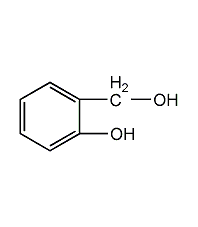
Structural formula
| Business number | 021S |
|---|---|
| Molecular formula | C7H8O2 |
| Molecular weight | 124.14 |
| label |
o-hydroxybenzyl alcohol, 2-Hydroxybenzyl alcohol, o-hydroxybenzyl alcohol, 2-hydroxybenzyl alcohol, 2-Hydroxybenzyl alcohol, Saligenin, o-Hydroxybenzyl alcohol, HOC6H4CH2OH |
Numbering system
CAS number:90-01-7
MDL number:MFCD00004617
EINECS number:201-960-5
RTECS number:DO6430000
BRN number:1907195
PubChem number:24850189
Physical property data
1. Properties: white flake or crystalline powder. Spicy.
2. Density (g/mL, 25/4℃): 1.16
3. Relative vapor density (g/mL, air=1): Undetermined
4. Melting point (ºC): 86~87
5. Boiling point (ºC, normal pressure): Undetermined
6. Boiling point (ºC, 5.2kPa): Undetermined Determined
7. Refractive index: Undetermined
8. Flash point (ºC): Undetermined
9. Specific rotation (º): Undetermined
10. Autoignition point or ignition temperature (ºC): Undetermined
11. Vapor pressure (kPa, 25ºC): Undetermined
12. Saturation Vapor pressure (kPa, 60ºC): Undetermined
13. Heat of combustion (KJ/mol): Undetermined
14. Critical temperature (ºC): Undetermined
15. Critical pressure (KPa): Undetermined
16. Log value of oil-water (octanol/water) partition coefficient: Undetermined
17. Explosion upper limit (% , V/V): Undetermined
18. Lower explosion limit (%, V/V): Undetermined
19. Solubility: Easily soluble in ethanol, ether and chloroform, Soluble in benzene and 15 parts of water. It turns red when encountering sulfuric acid.
Toxicological data
irritating
Ecological data
None
Molecular structure data
1. Molar refractive index 34.58
2. Molar volume (cm3/mol): 101.6
3. Isotonic specific volume (90.2K) :275.8
4. Surface tension (dyne/cm): 54.1
5��� Polarizability (10-24cm3): 13.71
Compute chemical data
1. Hydrophobic parameter calculation reference value (XlogP): 0.7
2. Number of hydrogen bond donors: 2
3. Number of hydrogen bond acceptors: 2
4. Number of rotatable chemical bonds: 1
5. Number of tautomers: 3
6. Topological molecular polar surface area (TPSA): 40.5
p>
7. Number of heavy atoms: 9
8. Surface charge: 0
9. Complexity: 83
10. Number of isotope atoms : 0
11. Determine the number of atomic stereocenters: 0
12. Uncertain number of atomic stereocenters: 0
13. Determine the chemical bond configuration Number of centers: 0
14. Number of uncertain chemical bond stereocenters: 0
15. Number of covalent bond units: 1
Properties and stability
None
Storage method
This product should be kept sealed.
Synthesis method
1. Add zinc acetate to a mixture of phenol and formaldehyde solution, adjust the pH to 5-6, slowly heat and reflux for 1 hour, vacuum distill to remove water and excess phenol, and the temperature does not exceed 100°C. The residue in the kettle is stirred evenly with carbon tetrachloride and then left to stand. The precipitated salicyl alcohol is crystallized again with carbon tetrachloride to obtain the finished product.
2. Preparation method:

Add 1.5 mL of 2 mol/L ferrous chloride aqueous solution, 0.5 g of platinum oxide, 73.2 g (0.6 mol) of salicylaldehyde (2), and 300 mL of 95% ethanol into the high-pressure reaction kettle. Replace the air with nitrogen, and then replace the nitrogen with hydrogen. Stir at room temperature under a pressure of 0.3MPa until hydrogen is no longer absorbed, which takes about 1 to 2 hours. Release the residual pressure and open the reactor. Add 1 to 2 mL of 1 mol/L sodium hydroxide solution, filter to recover the catalyst, and wash with 20 mL (95%) ethanol. Combine the filtrate and washing liquid, rotate and concentrate, and the residue is recrystallized with 150 mL benzene to obtain product ①(1) 67.9, with a yield of 92%. Note: ① This method can be used to prepare the following benzyl alcohols (Table I-5-7) [1]
Purpose
It is used to make coumarin and prepare spices such as violet. It is also used to synthesize the pesticide salicylthion and medicine.

 微信扫一扫打赏
微信扫一扫打赏

